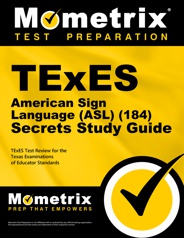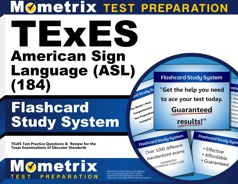The Texas Examinations of Educator Standards (TExES) American Sign Language exam is used to assess the skills and knowledge of prospective entry-level math and science teachers for 4th-8th graders in Texas public schools.
Click “Start Test” above to take a free TExES American Sign Language practice test, and check out our premium-quality TExES test prep resources by clicking the links below!
Exam Outline
The TExES American Sign Language exam contains a total of 80 selected-response questions, and you will be given 4 hours and 45 minutes to complete it.
Teaching Standards
The exam is aligned with nine standards for educators that have been outlined by the State Board for Educator Certification.
Click the button below to see the full list of approved educator standards:
Approved Educator Standards
Standard I: You are expected to understand general language acquisition, communication processes, historical and current research on American Sign Language, and signed languages used by Deaf communities in other countries.
Standard II: You are expected to understand language as a vehicle of culture and theories of second language learning.
Standard III: You are expected to understand effective methodologies for teaching American Sign Language, its history, and its evolution to modern usage.
Standard IV: You are expected to understand the grammatical features of American Sign Language and comparative and contrastive attributes of American Sign Language and English.
Standard V: You are expected to understand sociological theories, especially as related to the American Deaf culture and community, and compare and contrast culture.
Standard VI: You are expected to understand American Deaf culture and its evolution.
The questions on the exam are grouped into six competencies.
1. General Language Acquisition (15%)
The questions under this competency assess your knowledge and skills in the following areas:
- General language acquisition
- Historical and current research on American Sign Language
- Analyzing situations relevant to the acquisition and use of American Sign Language
- General similarities between American Sign Language and signed languages of other countries
2. Second Language Acquisition (15%)
The questions under this competency assess your knowledge and skills in the following areas:
- The transmission of language through culture
- The involvement of developing awareness and understanding of a second culture
- The role of social and interactive processes in language acquisition
- Similarities and differences in how culture is transmitted in both hearing and deaf communities
- Theories and concepts related to second-language learning
3. Teaching Sign Language (25%)
The questions under this competency assess your knowledge and skills in the following areas:
- Methods and approaches for teaching American Sign Language
- Advantages and disadvantages of various language-specific evaluation and feedback techniques
- Using assessments to enhance language learning
- Identifying, developing, and adapting appropriate materials and technologies for instruction
- Strategies for accommodating diverse language-learning styles
- Modifying language to be comprehensible and appropriate for instruction
- Incorporating aspects of deaf culture into instruction
- Connecting language study with the study of other academic disciplines
- The relevance of language learning outside of the classroom
- Including people who are deaf and other deaf community resource personnel in classroom instruction
- The history of American Sign Language and its evolution to modern usage
4. Linguistics of American Sign Language (20%)
The questions under this competency assess your knowledge and skills in the following areas:
- The major linguistic and grammatical features of American Sign Language
- The phonological structure of American Sign Language
- Effects of phonological processes on signs and combinations of signs
- Analyzing and correcting student production errors that are phonologically based
- Grammatical features of American Sign Language
- Fingerspelling, lexical borrowing, and numbers
- The syntax of American Sign Language
- The organization of the various forms of discourse in American Sign Language
- Various sociolinguistic aspects of American Sign Language
- Explaining the concepts of invented sign systems to students
5. Sociology and Cultural Anthropology (10%)
The questions under this competency assess your knowledge and skills in the following areas:
- Comparing and contrasting hearing and deaf cultures
- Analyzing and applying general sociological theories
- Demonstrating an understanding of the deaf community
- Recognizing that the deaf community is a cultural and linguistic minority within the majority culture
- The multicultural aspects of and diversity within the American deaf culture
- Characteristics of people who are culturally deaf and of the deaf community
- Participating in the deaf community
6. Aspects of the Deaf Culture (15%)
The questions under this competency assess your knowledge and skills in the following areas:
- The history and evolution of deaf culture
- International deaf cultures and organizations
- How people who are deaf are viewed
- Educational facilities and educational issues of concern to the deaf community
- Services and cultural organizations related to the deaf community
- The history and current status of technology and the evolution of communication access for individuals who are deaf or hard of hearing
- Deaf culture’s language, customs, rules, traditions, and values for social interaction
- The folklore of the deaf and their culture
- Major contributions and accomplishments of individuals within the deaf community in historical events, the arts, and pop culture
- Federal and state laws regarding the education and civil rights of individuals who are deaf
Check Out Mometrix's TExES American Sign Language Study Guide
Get practice questions, video tutorials, and detailed study lessons
Get Your Study Guide
Registration
To register for the American Sign Language exam, you must create an online NES account via their website. Once your account has been created, you can use it to register for the exam and schedule an exam date.
When you register, you will need to pay the $116 examination fee.
Test Day
On test day, you should arrive at the testing center 15-30 minutes before your scheduled appointment. When you arrive, you will be asked to sign in and present one form of valid, government-issued photo ID.
After the check-in process, you will be asked to leave all personal items in a locker outside the testing area.
Once you enter the testing room, you will be asked to sign an NDA, and you will be given a brief tutorial on the computer-adaptive testing system. Once the tutorial is complete, the exam will begin.
How the Exam is Scored
The TExES American Sign Language exam is computer-adaptive. Here’s a look at how it works:
The first question is judged to be of medium difficulty, and depending on your performance, the next question may be easier or harder. If you do well on the first question, the second question will be harder; conversely, if you do poorly on the first question, the second question will be easy.
The questions on this exam are rated on a scale of 100-300. The higher a question is rated, the harder the question is (e.g., a question marked as 230 will be more difficult than a question marked 160).
To pass the exam, your final question must be on or above the 240 mark. If your final question is below this mark, you will not pass the exam, even if you have answered some questions above the 240 mark at some point during the exam. This is because the computer has rated the difficulty of your final question based on how you answered the previous questions.
Check Out Mometrix's TExES American Sign Language Flashcards
Get complex subjects broken down into easily understandable concepts
Get Your Flashcards
FAQs
Q
How many questions are on the TExES American Sign Language exam?
A
There are 80 selected-response questions on the exam.
Q
How long is the TExES American Sign Language exam?
A
The time limit for the exam is 4 hours and 45 minutes.
Q
What is the passing score for the TExES American Sign Language exam?
A
To pass the exam, you must achieve a scaled score of at least 240.
Q
How much does the TExES American Sign Language exam cost?
A
The examination fee is $116.
function toggle(obj) {
var obj=document.getElementById(obj);
if (obj.style.display == “block”) obj.style.display = “none”;
else obj.style.display = “block”;
}

